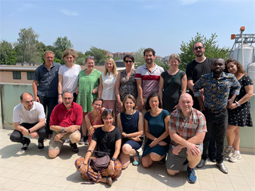Fighting antimicrobial resistance through the integrated approach of One Health

At a glance
Issue
Microbes such as bacteria and certain parasites that affect humans, animals and crops are commonly fought off with antibiotics and other antimicrobial drugs. But the natural evolution of microbes, in addition to overuse and misuse of these drugs, is making these tactics less effective.
Antimicrobial resistance (AMR) now poses a major threat to human and animal health, the environment and the economy. AMR is a challenge that has been taken up by proponents of a One Health approach to science in which researchers from across disciplines study problems at the intersection of people, animals and their environments to search for common solutions that leave us all better off.
Research
With CIHR funding, researchers across the country are embracing One Health. Dr. Jenine Leal, a specialist in epidemiology and health economics at Alberta Health Services and the University of Calgary, focuses on the economic impact of AMR. Dr. Cécile Aenishaenslin, a veterinarian and epidemiologist at Université de Montréal, studies AMR surveillance systems.
Impact
Dr. Leal conducted a review of the current tools used to predict the presence of antimicrobial-resistant organisms in hospitals and found that the greatest risk factors for patients in hospitals were previous hospital admission, recent antibiotic exposure, and age and sex. Dr. Aenishaenslin has developed a model to evaluate AMR surveillance systems that has been adopted by many other countries.
Related stories
Antimicrobial drugs, including antibiotics, antivirals, antifungals and antiparasitics, are a cornerstone of modern medicine. By treating common and life-threatening infections in both people and animals, and protecting plants and crops, these drugs play a critical role in human and animal health, as well as agriculture and food production. But the microbes that infect humans, animals and plants are developing antimicrobial resistance (AMR), which means common infections and injuries are becoming more difficult to treat. This has far-reaching implications for human health and animal care, food safety and the economy.

"Antimicrobial resistance is a silent pandemic," says Dr. Jenine Leal, a research scientist at Alberta Health Services and assistant professor in the Departments of Community Health Sciences and Microbiology, Immunology, and Infectious Diseases at the University of Calgary. "It's not just bacteria that are becoming resistant to antimicrobials, but viruses, fungi and parasites as well. This has significant consequences, not just for human and animal health, but also for the environment and the health care system."
In Canada, according to a report by an expert panel of the Council of Canadian Academies, 26% of bacterial infections in humans were resistant to first-line antimicrobials in 2018. The report estimated that drug-resistant bacterial infections were associated with the deaths of more than 14,000 people in Canada in that same year. More than a third of those deaths could have been prevented if first-line antimicrobials had been effective. Between 2018 and 2050, the panel anticipates the proportion of infections resistant to antimicrobials in Canada will grow from 26% to 40%. In this scenario, deaths directly attributable to AMR would more than double to 13,700 per year.
Many factors influence the development of AMR, including the natural evolution of microbes; overuse and misuse of antimicrobials in human health, animal health and agriculture; socio-economic and health system disparities both in Canada and globally; and the lack of new antimicrobials and antimicrobial alternatives, among others. In June 2023, in collaboration with Indigenous Peoples and sectoral partners, the federal, provincial and territorial ministers of health and agriculture released the Pan-Canadian Action Plan on Antimicrobial Resistance. The action plan provides a five-year blueprint to coordinate and accelerate Canada's response to AMR.
One of the action plan's key principles is "One Health" — an approach launched by the World Health Organization in 2017 to connect the dots between human health, animal health and their shared environment. With funding from CIHR, researchers are evaluating the economic burden of AMR to the health care system and society and developing tools to make better use of data. In this way, they are helping Canada grapple with the multi-faceted challenges of AMR.
Understanding the cost of AMR to health care systems
As a teenaged volunteer at a Toronto emergency department, Jenine Leal would wear personal protective equipment to interact with high-risk patients. The experience piqued her interest in infection prevention and control, setting the stage for graduate studies in epidemiology. After a few years of working in the field, she pursued a PhD in health economics to explore the economic impact of such infections on the health care system, and especially the role of AMR.
The economic impact of AMR is considerable. AMR cost the health care system and Canada's gross domestic product an estimated $1.4 billion and $2 billion, respectively in 2018. Between 2018 and 2050, the annual economic fallout of AMR could skyrocket from $2 billion to $21 billion due to impacts on labour productivity. This would lead to a cumulative decline in gross domestic product of $388 billion by 2050.

Building on her background in epidemiology, Dr. Leal is using electronic medical records to assess hospital screening protocols for antibiotic resistant organisms in Alberta and Ontario. For example, are new patients swabbed on admission to ensure they are not carrying antibiotic-resistant organisms into the hospital? Surveys and focus groups with nursing staff are also planned to gain insight into the challenges of screening for AMR. By identifying gaps in how admissions are handled, she can start to identify the most cost-effective improvements to these protocols.
One potential improvement to these screening protocols is the use of artificial intelligence to figure out which admitted patients are at high risk of antibiotic resistant organisms using electronic medical records and other data sources. She focuses on understanding the best tools to predict the presence of methicillin-resistant Staphylococcus aureus (MRSA), as well as carbapenemase-producing organisms (CPOs).
MRSA is a staph bacterium that resists first-line antibiotics including methicillin, oxacillin, penicillin and amoxicillin, while CPOs are bacteria that are resistant to second-line antibiotics such as carbapenems. Dr. Leal has found that risk factors like recent antibiotic exposure, age and sex are the most common factors that can predict the presence of antibiotic-resistant organisms among hospitalized patients.
Making sense of AMR through the lens of quantitative and qualitative data
For more than two decades, the Canadian Integrated Program for Antimicrobial Resistance Surveillance (CIPARS) has greatly contributed to the fight against AMR in Canada. Coordinated by the Centre for Food-borne, Environmental and Zoonotic Diseases and the National Microbiology Laboratory of the Public Health Agency of Canada, CIPARS collects, analyzes and communicates trends in antimicrobial use and resistance. In recent years, it has integrated a One Health approach into its surveillance system, but the sheer amount of data available has been overwhelming.

"They have a gigantic network of partners from different disciplines," says Dr. Aenishaenslin, a veterinarian and epidemiologist at Université de Montréal. "These range from producers using antimicrobials on their farms to members of the pharmaceutical industry and clinicians. And each province collects and treats data differently. We sometimes think 'more data is better.' Maybe we should ask, 'what information do we need to make better decisions?'"
With this in mind, Dr. Aenishaenslin led a study of how well CIPARS had integrated a One Health approach into surveillance systems for antimicrobial use and resistance. "We discovered a paradigm shift in how people understand the data," she says. She found that the CIPARS team collaborates with numerous partners in the field to help interpret and disseminate the surveillance results. These long-standing collaborations have helped establish a climate of trust, notably with the animal production industry, which has encouraged changes in antimicrobial use practices. For example, CIPARS greatly contributed to the poultry industry's voluntary ban of ceftiofur — an antibiotic used to control respiratory tract infections.
"Most of my projects use both quantitative and qualitative methods to analyze One Health approaches, including individual interviews and focus groups," she says. "Both methods are important to understand how One Health is creating added value to surveillance. We need to hear different perspectives to make sense of its complexity."

In partnership with CIPARS, Dr. Aenishaenslin and her team developed a framework that looks at how well the AMR surveillance system integrates the One Health approach; produces related information and expertise; explains trends and increases awareness; influences policy; and leads to better decisions.
Dr. Aenishaenslin also leads CoEvalAMR, an international network that is working to enhance the ways we evaluate the current systems in place for surveillance of antimicrobial use and resistance. Through this network, countries such as France, Italy and Denmark have adopted the framework developed by Dr. Aenishaenslin and her team. The network is documenting how different countries evaluate a One Health approach to surveillance and setting up a menu of best practices on its website.
Read more Health Research in Action stories.
- Date modified: